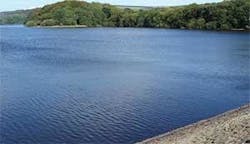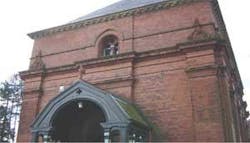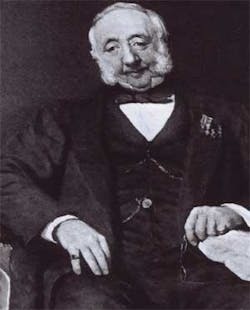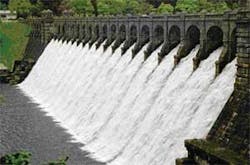A Forgotten Hero Thomas Hawksley (1807–1893)
The founder of global environmental services firm MWH – whose roots are in his pioneering engineering practice begun in England in 1844 – and who advanced the cause of proper water supplies and sanitation in the 19th century is recognized 200 years after his birth.
December marks the end of the bicentenary year of the birth of renowned civil engineer Thomas Hawksley, one of the greatest 19th century water engineers. In his lifetime, he achieved international recognition for developing the first pressurised clean water supply available at the turn of a tap. This system saved countless lives when cholera struck Great Britain in 1848–9 and is one of the reasons the country’s health and prosperity accelerated ahead of many others in the following decades. He received knighthoods and tributes from Sweden, Denmark, Brazil and other grateful countries for solving their water problems, as well as honours from industry peers who elected him president of the Institute of Civil Engineers (ICE). Despite a career of achievement and social change and although many of the waterworks he created are still in use as forerunners of today’s modern water supply systems, he’s now largely unknown and forgotten.
To remedy this, presented here are research and interviews with Tony Keyworth, branch chairman of CIWEM – East Midlands, who is in the process of co–writing a book about this talented engineer, as well as Ken Farrer, vice chairman of MWH – a leading service provider in the water industry that Hawksley helped to found.
From humble beginnings
“Thomas Hawksley was born the son of a manufacturer in Arnold near Nottingham on 12 July 1807. He received a basic education at the Nottingham Grammar School before leaving at 15 to join architect Edward Staveley the Corporation as a surveyor. A highly talented mathematician, he was also, like most engineers, more interested in doing and was largely self–taught. At the age of 23, he was appointed as Engineer to the Trent Water Company and built a waterworks near Trent Bridge in Nottingham. The water was obtained by filtration through the sands and gravels and pumped to the town to a reservoir from which he installed an extensive distribution system”, explains Keyworth.
Water supply and distribution are probably the most important of Hawksley’s gifts to the nation. A stickler for calculations prepared with mathematical precision, whether he was using gathering grounds or pumping systems, he acquired a considerable reputation as a hydraulic engineer creating waterworks all over the country. In regard to the quality of the water, he insisted on “wholesomeness” and what he called “practical purity”. This meant that, although he obtained the best chemical support available, he had no time for those that objected to “a millionth of a grain of inoffensive matter per gallon of water”. This led him in many cases to recommend that rivers were the natural and proper source of supplies – for example, he insisted on the Trent in Nottingham and the Thames in London. The vast scientific knowledge and experience he built up gave great confidence to his clients
Through his ingenuity, Nottingham became the first of many places in the world to benefit from a pressurised supply of water available by the turn of a tap 24 hours a day. This system, universal today, was then considered unachievable due to difficulties of designing pipes and fittings that didn’t leak away the water. His redesigned screw–down tap eliminated premature wear and water hammer pressures that were a feature of the old quarter–turn cocks. Keyworth pointed out: Hawksley’s pressurised system saved huge numbers of people when a cholera epidemic struck the country in 1848–9 – with Nottingham actually escaping the infection. In an earlier outbreak in 1832, he designed a cholera hospital, laying on a water supply and even attending the sick.
In addition to his many years of service to water companies, he was known for his pioneering work in gas engineering and being a strong voice for social reform. He was engineer to the Nottingham Gaslight & Coke Company, building three large gasworks in Nottingham that operated until the mid–20th century. His gas engineering skills were employed in several major cities worldwide.
Hawksley revolutionised mains drainage, including collection and disposal of sewage in major conurbations such as Birmingham, Worcester, Herford, Windsor, Whitehaven, Aylesbury and London. He strongly advocated chemical treatment of sewage so it might be rendered harmless before being discharged into rivers. He foresaw difficulties sanitary arrangements of large towns would produce. At that time, most towns were grossly overcrowded as people came seeking work at factories and mines. In Nottingham, housing standards were particularly poor, with inadequate sanitary facilities. Recognising that building better housing was being frustrated by refusal of the freemen and burgesses to allow the common land around the town to be built on, Hawksley led a group that forced through a parliamentary bill.
His work reached the attention of social reformer, Edwin Chadwick, who asked him to be a principal witness at “The Commissioners’ Enquiry into the State of Large Towns” in 1843–4. He impressed them with his submissions on the connection between mortality rate and the overcrowding and inadequate drainage in Nottingham. His reputation was considerably enhanced by his explanations of the effectiveness of his Nottingham system, the advantages it held for public health and the well–being of the population. He also very publicly criticized Nottingham Corporation and the slum landlords for their failure to deal with this appalling situation.
In great demand
In 1852, he moved to London and practised from 30 Great George Street for 40 years. Ken Farrer, summarises his long career: “He focused on three key areas of municipal engineering – water–supply, gas–supply and main drainage. His practice became so large that it would be impossible to list all his works. However, he used to say that he had constructed over 150 waterworks, ‘many of the largest kind’. Indeed it would be true to say that there were no important towns in Great Britain that had not consulted him in some way; and many major cities around the world were grateful for his involvement in creating their water–supplies, gas or lighting systems.”
Some of the schemes Hawksley designed abroad include gasworks in Bombay, India (now Mumbai) and Denmark; waterworks in Stockholm, Sweden, Altona, Denmark, and Vienna, Austria. As a result of these works, he was awarded the Swedish order of the Polar Star and Denmark made him a Knight of Danebrog. He was also made a Commander of the Order Franz Josef of Austria and a Commander of the Rose of Brazil.
Farrer adds: “Hawksley founded what has become a global company with over 6,000 employees who still share his key values of innovation combined with precision, quality and sustainability. His son Charles joined him in 1866 creating T&C Hawksley, followed by his grandson Kenneth and his great–grandson, Thomas Edwin, who headed the company until 1972. Following a merger with public health engineers J.D. and D.M. Watson, the company became, in 1978, Watson–Hawksley, Montgomery–Watson–Hawksley in 1992 and finally MWH in 1997”.
Major innovative designs
Although scarcely a large city in Europe did not make use of Hawksley’s services, his closest connections were with the UK cities of Liverpool, Sheffield, Nottingham and Leicester. When Liverpool needed additional water, Hawksley proposed the Rivington Pike scheme. This caused years of political infighting because it vied with a scheme by Borough Engineer James Newlands, who designed and installed the city’s first integrated sewer system, to extend the deep well system. Fortunately, the “Pikists”, finally won the day when Robert Stevenson endorsed Hawksley’s proposals. Completed in 1857, this spectacular reservoir scheme was the biggest of its kind and, today, still supplies Liverpool’s water.
“The three Weardale Dams built between 1872 and 1879 are also typical of Hawksley’s talents,” says Keyworth. “The Waskerly dam was where he introduced moss into the slip joints between culvert and valve well to provide articulation. This ingenious attention to detail successfully avoided fractures and leakage that were so damaging to earthen dams. Similarly, when the Tunstall dam was discovered to have a large leak at the end of the puddle wall, Hawksley ordered holes be drilled from the surface and cement grout poured in. This pioneering technique – now called grouting – stopped the leakage.”
He completed dams for Leeds, Leicester, Rochdale and Sheffield (where he was consulted over the Dale Dyke dam collapse of 1854 and subsequently built three further dams). Sadly, of all the pumping stations he built, the only survivor with the mechanical plant intact is at Ryhope in County Durham, built in 1868.
Call for knighthood?
A leader in his profession, as well as president of ICE (1871–73), he served as president of I.Mech.E. (Institute of Mechanical Engineers) during 1876–77. He was an Elected Fellow of The Royal Society (1878), founder and president of the British Association of Gas Managers (1864–1867), and Health Section president of the National Association of Social Sciences, often speaking on social issues.
Both Keyworth and Farrer underline the huge debt owed to Thomas Hawksley: “Alongside John Frederic La Trobe Bateman, he was the leading British water engineer of the 19th century. As a minimum, he should have an entry in our school history books. He should be accorded the popular attention that is heaped on the great railway engineers such as Brunel, Stephenson and Telford,” suggests Keyworth.
Farrer adds: “A posthumous knighthood would not be inappropriate, given the huge leap forward he gave Great Britain and other countries by providing their populations with clean safe water, 24/7, and safe sanitation with its inextricable links to population health and prosperity.”
MWH is a global leader in engineering and construction consulting services and a leading service provider in the water industry. With over $1 billion in revenue, its 6,100 specialists in 36+ countries provide premiere solutions to municipalities, government agencies, multinational companies, industrial concerns and military organizations. Contact: [email protected]





